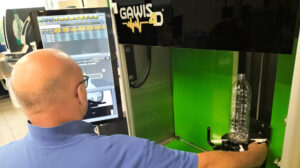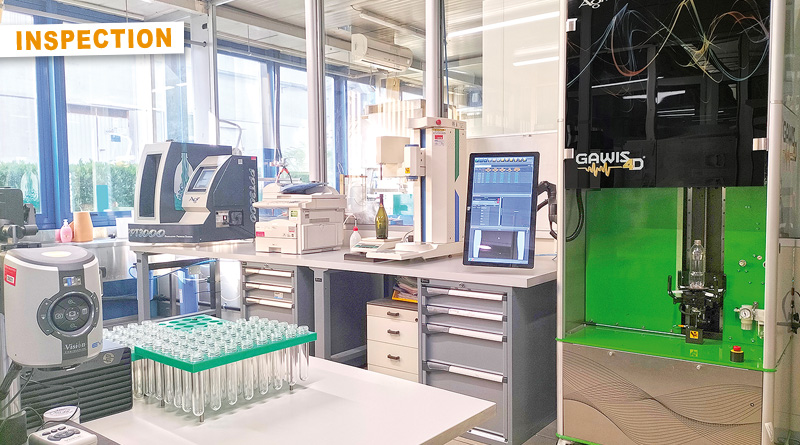Laboratory throughput – the name of the game!
Agr’s Gawis 4D – a winning solution for Sipa
Sipa S.P.A., with headquarters in Vittorio Veneto, Italy, is well known in the plastics industry for its expertise in producing a range of high-end PET preform and container moulding systems. Being one of the few companies that has experience with both preforms and containers, they are uniquely positioned to offer a one-stop experience for a complete production line – from resin to finished product, including preform manufacturing, bottle and mould design and production, filling, capping and palletising.
Regardless of the product supplied, quality has the highest priority, and the Sipa design, testing and qualification Laboratory managed by Roberto De Luca is tasked with ensuring that every product manufactured is to specification and meets Sipa’s strict standards. That means that every product, large or small, must be measured and tested before going out the door. And with the number of products Sipa produces, this can be a daunting task. To meet the increased demand for quality assurance measurement in the lab, Sipa recently added the Gawis 4D from Agr International, a high precision dimensional and thickness measurement system for bottles and preforms. “In the lab, we perform tests of samples from all moulds and machines to verify that they can produce finished product in compliance with customer or Sipa specifications. This includes the testing of 100% of injection, blowing and one-stage machines and moulds on delivery,” explained Mr De Luca.
Keep in mind that Sipa is the second largest supplier worldwide in both preform and container moulds with state-of-the-art tooling facilities. Therefore, when it comes to testing and mould qualification, the numbers are significant. This is an important part of the business, and the testing of these moulds is a key aspect.
This is where the Gawis 4D comes in. The number of cavitation on a preform mould has increased from 96 being standard to 144 to 180 and now 200 cavities in a mould set. This means more samples to test. According to De Luca, when they qualify a mould, before shipping to the customer, samples from every cavity must be measured to verify that they meet specifications including body dimensions, thread attributes for proper closure fit, perpendicularity and thickness. With the expanded number of cavities, this has dramatically increased the testing load on the lab.
The Gawis 4D was purchased to help meet this increased demand. The speed of tests on the Gawis 4D system, leading to reduced cycle time, was a principal factor in the decision to add the 4D to the Sipa lab. Another “winning feature is the combination of dimensional and thickness measurement at the same time – this is important to reduce cycle time. And, of course, the accuracy of the system as well,” claimed De Luca.
The fact that the Gawis 4D can measure both preforms and containers is very important. “One week we are focused on testing bottles and next week it is mainly preforms. If we had an instrument that only did one or the other, it would sit idle part of the time. With the Gawis 4D, its capability is used 100% bringing good value to our operation.”
The time factors
Measuring a preform by hand can take several minutes, while the Gawis 4D can perform the measurements in less than one minute. When qualifying a mould with 180 preforms, the time savings is significant, as much as 30% or more. Even if it only takes one minute longer by hand, this is 180 minutes, or 3 hours more to qualify a mould set. Also, one needs to consider the variations in measurement attributed to the technician, and of course, the time to document the data. With the Gawis 4D, measurements are performed on every container or preform, exactly the same, avoiding any type of discrepancies due to human error, all in a fraction of the time. When thousands of measurements have to be performed, this is important, and the time saving is considerable.
Another reason for selecting the Gawis 4D is its ability to efficiently perform thickness measurements even of small preforms and containers. As De Luca noted, the alternative is to make hand measurements with a magnetic gauge for thickness. The Gawis 4D, with its non-contact thickness measurement, eliminates the need to do thickness manually, which takes a lot of time. This goes for large containers as well as the very small. “We need to measure both thickness and thickness variation over and around the preform or bottle wall. Material distribution analysis takes time.” The Gawis 4D captures hundreds of measurements over the length and around the circumference of the preform. This makes it quite simple to measure thickness variation as well as other attributes such as concentricity, min/max and average in a single measurement sequence. On the Gawis 4D this is performed in conjunction with dimensional measurements, in less than one minute. Additionally, the Gawis 4D is industry 4.0 compatible making it possible to easily communicate with other devices and share data.
Testing, testing, testing…
One of the defining aspects of Sipa is the wide portfolio of products that includes beverage bottles, preforms, jars, small and large containers and even, detergent containers. Testing and measuring are not limited to new machines and moulds. Nowadays, most of the projects coming through the Sipa lab are pretty challenging, including lightweighting or new resins testing, with the focus on sustainability. Taking measurements is not as easy as people might think. “Everything is extraordinary” – every week is a new challenge and any savings in time is welcome.

AutoJob
Since time and accuracy are of the essence in this facility, taking into account the wide variety of products, one of the biggest challenges typically associated with automated measurement systems is the amount of time it takes to program each job. The Gawis 4D addresses this handily with a patented feature called AutoJob. With this feature, the operator simply selects the AutoJob mode and the work of locating and identifying finish features is performed automatically and incorporated into the job within a matter of seconds. The operator can adjust the selection, add control limits, and incorporate additional measurements as necessary. AutoJob can be used to create a new job or identify an existing job template, through template matching, that most closely matches the container. Template matching, another feature associated with AutoJob, finds the closest match of a scanned bottle finish to a job template already in the template library, or published standard template. The work in this lab goes well beyond qualifying
machines and moulds. Typically, there are several projects running at the same time. “R&D projects are also very important as they are the future of the company” explained Mr De Luca. “A typical R&D project involves making a completely new bottle from zero. We have a department dedicated to this activity to capture ideas and feeling from the market. Sometimes these are brand new designs. We also refresh bottle designs and work through the process.” To support this work, the lab strictly interacts with the prototyping department where several machines – injection press, one-stage machines, single cavity blow moulders – are dedicated to prototype new containers. This provides a realistic check before releasing the bottle for commercialisation. Whether brand new or existing, the lab supplies the testing necessary to validate the design.
Long-term relationship
Another important part of the decision to purchase the Gawis 4D is Sipa’s long-term relationship with Agr. The Gawis 4D is now the third Gawis measurement system working in the Sipa lab. The first was purchased in 1999, another in 2016 and the latest Gawis 4D, last year. “Before purchasing the latest system, we evaluated other devices – but we found that the Gawis 4D was the only system that had all the features we wanted, particularly the capability to do preforms and containers with the same system and simultaneous thickness and dimensional measurement … these were most important features. The Gawis 4D was a significant upgrade over the previous systems.”
In addition to the Gawis systems, the Sipa design, testing and qualification laboratory also includes the Agr PPT3000 pressure tester, Agr Combi tester for volume and top load tests and an Agr vacuum tester for qualifying vacuum strength of hot fill containers.
As Sipa continues to grow and sell more equipment and moulds, the demands of the lab increase as well. According to De Luca, the new equipment has helped them keep up with these demands. Additionally, they are planning a lab expansion targeted for January of next year to aid with these increasing demands.
In essence, the faster the measurements and response, the better it is for everyone. Since the work in the lab plays a critical role in the Sipa operation, it is imperative that the testing related to the qualification of moulds and equipment for shipment have no delays. “The new Gawis 4D system is essential to this effort as it has made it possible to increase our throughput and help us work faster and better. The faster we give response the better it is for everyone. The laboratory is of such importance to Sipa operation that any improvement in quality and throughput is a definite advantage.”

